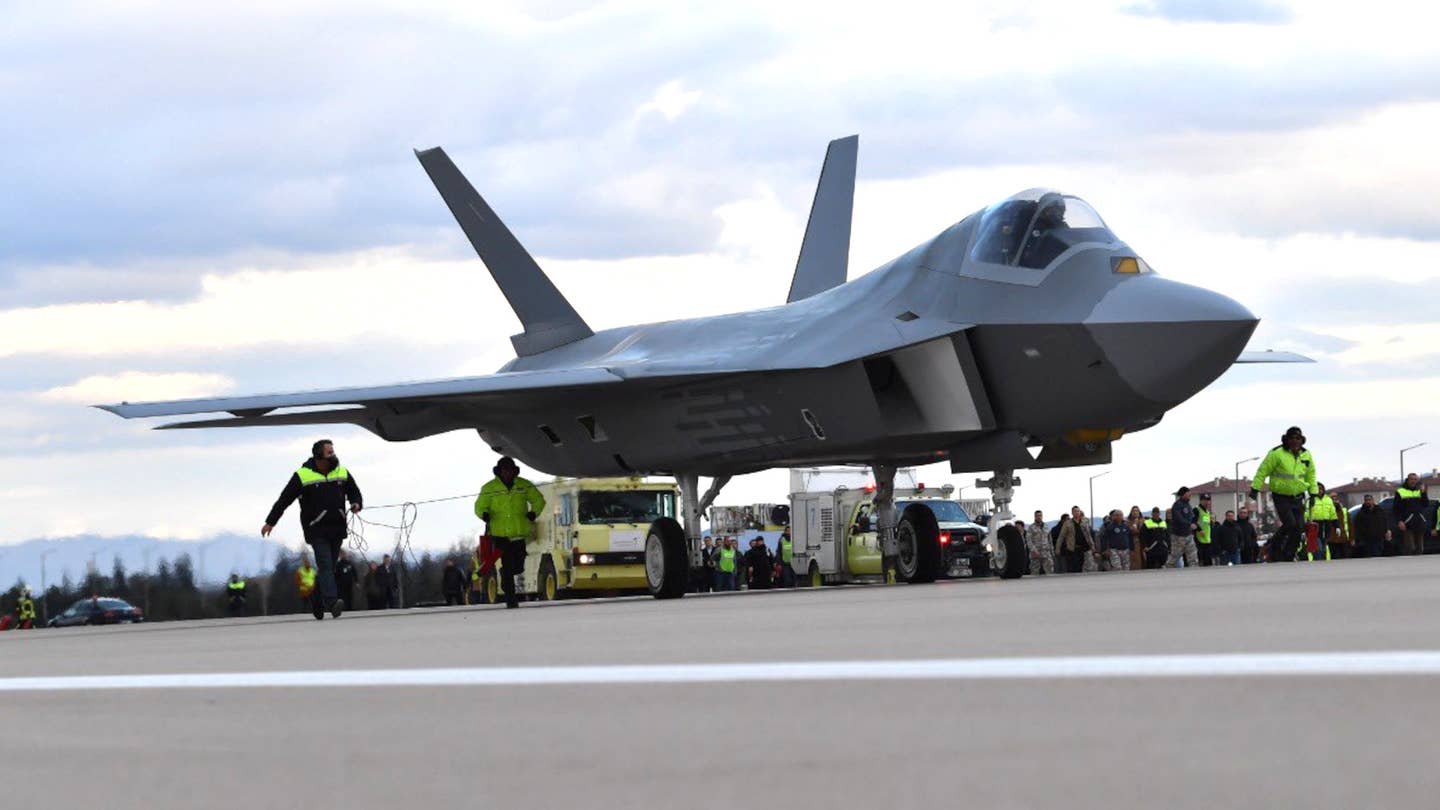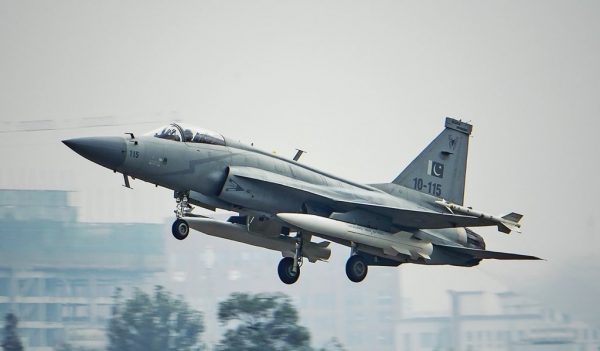China’s FC-31 Stealth Fighter Officially Being Sought By Pakistan
The chief of the Pakistan Air Force says that the Chinese new-generation fighter is “all set to become part of the fleet in the near future.”
BY
THOMAS NEWDICK|PUBLISHED JAN 5, 2024 5:09 PM EST
THE WAR ZONE
Chinese internet
SHARE
THOMAS NEWDICK
View Thomas Newdick's Articles
CombatAir
The Pakistan Air Force (PAF) says it’s lining up a purchase of Chinese-made Shenyang
FC-31 stealth fighters, a move that could make it the first operator of the medium-weight combat aircraft and which would add another type to an already highly diverse inventory.
Preparations to buy the FC-31 were announced by the PAF boss, Air Chief Marshal Zaheer Sidhu, during a recent ceremony to showcase newly acquired types (not including the FC-31) at an undisclosed airbase in Pakistan. A summary of Sidhu’s comments was published in a video on the PAF’s
official Facebook page earlier this week.
Air Chief Marshal Zaheer Sidhu, the Pakistan Air Force chief, at the podium, during the recent ceremony at which plans to procure the FC-31 were announced.
PAF Facebook page
“The foundation for acquiring the J-31 stealth fighter aircraft has already been laid, which is all set to become part of the fleet in the near future,” the summary stated.
At this stage, there is no word on how many FC-31s might be acquired by Pakistan, or when they might be delivered. It’s also unclear how far along any such acquisition might be. But even if the details are is still being decided at this stage, it’s nonetheless a significant announcement.
The
Development of a naval version of the aircraft, known as the
J-35, continues apace for China, with strong indications that it’s intended to eventually form
part of the air wing of that country’s latest aircraft carrier, the catapult-equipped
Fujian.
However, China has so far not shown any apparent interest in a
land-based version of the aircraft, which has also been offered for export as the FC-31, popularly known as the Gyrfalcon. Indeed, it seems probable that the FC-31 was originally developed with export potential strongly in mind. It's also worth noting that this aircraft is sometimes referred to as the J-31, which could become its Chinese Air Force designation if it were ever procured.
Two prototypes of the FC-31 were completed, the second featuring various refinements, which you can read about
here, after which the focus seemingly switched to the naval J-35, yielding at least another two prototypes.
The first FC-31 prototype taxis after a flight at the Airshow China 2014 in Zhuhai, on November 11, 2014.
JOHANNES EISELE/AFP via Getty Images
Two photos of the refined second FC-31 prototype.
Chinese internet
Intriguingly, however, imagery that emerged in September 2023 suggests that there may be a new prototype, perhaps adapted specifically for land-based use. This development led to rumors that China may still be pursuing a land-based version of the aircraft, which would likely be aimed at the People’s Liberation Army Air Force (PLAAF) as well as foreign customers — like Pakistan.
You can read our analysis of this potential new prototype
here.
Regardless of new developments involving land-based FC-31 prototypes, the aircraft has clearly attracted the interest of the PAF, which has an established tradition of buying Chinese-designed fighters, as well as co-developing and manufacturing them.
The Pakistan Aeronautical Complex continues to build successively more advanced versions of the
JF-17 Thunder, an aircraft that was jointly developed with China’s Chengdu.
Pakistan also became the first export customer for Chengdu’s
J-10 multirole fighter. The first of the
J-10CE version were delivered to Pakistan
in early 2022 and there are reports that 15 or as many as 36 examples could eventually be acquired.
Bearing in mind this procurement pattern, acquiring the FC-31 next would make a good deal of sense.
It should be noted that the exact degree of low observability (stealthiness) the FC-31 provides is not known openly. On the other hand, even a reduced radar signature, especially from the forward hemisphere, is a major advantage.
The aircraft’s low-observable capabilities combined with what is assumed to be an
advanced active electronically scanned array (AESA) radar, and likely an array of advanced weaponry, would represent a major advance over the JF-17 and J-10, let alone the ancient
Mirages that also still equip the PAF’s fighter force.
The other major fighter used by the PAF is the
F-16 acquired from the United States in several batches beginning in the 1980s, amounting to around 80 aircraft in all. F-16 deliveries to Pakistan were interrupted by an arms embargo in response to Pakistan’s
nuclear weapons program. Since then, 18 advanced F-16C/D Block 52 aircraft have been delivered, but meanwhile, Pakistan, and the PAF, have established increasingly close military ties with China. This puts a question mark on the chances of future F-16 deliveries — as well as support for the existing fleet, especially in wartime.
With Pakistan having an established aerospace manufacturing base, as well as an existing cooperation arrangement for the JF-17 program, it’s also possible that it could become involved in assembly or component manufacture for the FC-31.
Working on a stealthy fighter, even as a subcontractor, would provide Pakistan with highly valuable experience. But even without this kind of cooperation, introducing the FC-31 to the PAF would also make a considerable statement of intent. After all, its major regional adversary, the Indian Air Force, has yet to introduce any kind of stealth fighter and its domestic efforts to develop a warplane in this class are unlikely to yield results any time soon. On the other hand, the FC-31 has been flying since 2012, although so far it remains only in prototype form.
Were the PAF to introduce the FC-31 it would certainly lead to consternation in India and may also see renewed interest in the U.S.-made
F-35 stealth fighter, which has been pitched to the country
in the recent past. While comparisons are frequently, and not surprisingly, made between the FC-31 and the F-35, it should also be noted that even if it doesn’t approach the level of all-round capabilities offered by the Joint Strike Fighter, it can still be a highly relevant asset, especially if it can be acquired and operated
at a much lower cost.
If Pakistan follows through with its plans for FC-31 it may very well end any prospect of acquiring the
Turkish Aerospace Industries TF-X. In August 2023, the Turkish Minister of Defense Hulusi Akar suggested that Pakistan was considering buying the fighter, which is also known as Kaan.
While there are questions about its level of stealth, the TF-X has been developed with a reduced radar signature in mind, as well as high performance and advanced avionics and other systems. It is expected to make its first flight any time soon.
In our
previous coverage of the potential new land-based FC-31 prototype, we noted the similarities between the two designs and how both could be potentially attractive to certain export customers:
Even if the PLAAF remains lukewarm about the FC-31, there remains a big possibility that it would attract foreign customers, especially as it’s likely to be offered at a substantially lower cost than competing Western designs and without the tight export restrictions that typically come with them. In this sense, the export-optimized FC-31 follows the pattern of the South Korean KF-21 Boramae and the Turkish TF-X, being medium-weight advanced fighters with various efforts to reduce radar signature, while also offering high performance and advanced avionics and other systems. Basically, for those countries who cannot obtain an F-35 or even one of these other aircraft, the FC-31 could provide a modern fighter with some of the competition's advantages at a lower cost.
The TF-X next-generation fighter prototype during taxi tests ahead of its formal rollout in March 2023.
SSB
Once again, bearing in mind the close military relationship between China and Pakistan, the FC-31 would appear to be the more likely choice for a stealth fighter, should the PAF be getting one any time soon.
It would follow recent PAF procurement of other advanced Chinese-made defense equipment, including YLC-8E radars, which have been touted by China as an ‘anti-stealth’ radar, as well as HQ-9B long-range surface-to-air missiles. Both those acquisitions point to the continued effort to establish a technological edge over the Indian Air Force, with the FC-31 would continue.
It should also be recalled that Pakistan has aspirations to produce its own new-generation fighter. service’s latest video, which includes concept art of a new-generation, somewhat stealthy-
looking twin-engine fighter, with canard foreplanes. In March 2021, the PAF said it aimed to have a new fighter in the air by 2028, under Project AZM. This seems an unrealistic goal, although were Pakistan to join the FC-31 program, such an ambition could be realized, at least in part.
At this stage, there is no confirmation of any firm Pakistani order for the FC-31. However, the fact that the Pakistan Air Force chief sees the stealth fighter as part of its future plans reinforces the fact that efforts continue to modernize the service to meet threats from India and elsewhere.
Contact the author: [email protected]


aviationweek.com















